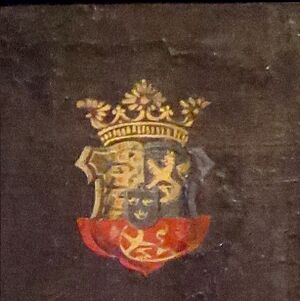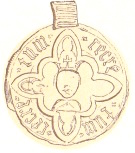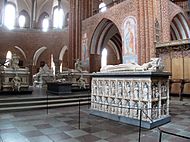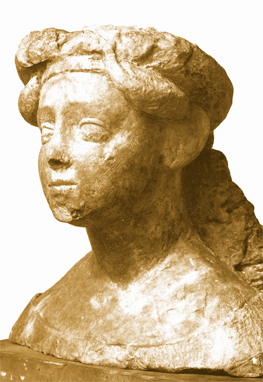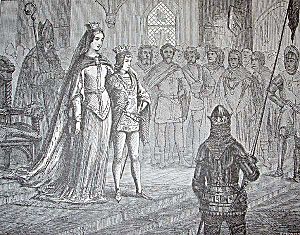Margaret I of Denmark facts for kids
Quick facts for kids Margaret I |
|
|---|---|
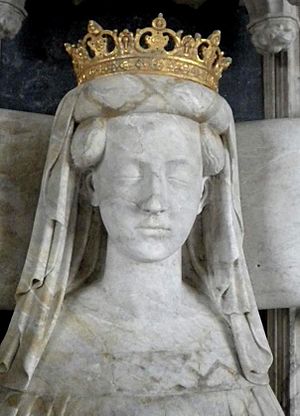
Effigy of Queen Margaret from 1423 on her tomb in Roskilde Cathedral.
|
|
| Queen of Denmark | |
| Reign | 10 August 1387 – 28 October 1412 (also regent for her co-sovereign Eric) |
| Predecessor | Olaf II |
| Successor | Eric of Pomerania (as sole sovereign) |
| Co-ruler | Eric of Pomerania (from 1396) |
| Queen of Norway | |
| Reign | 2 February 1388 – 28 October 1412 (also regent for her co-sovereign Eric) |
| Predecessor | Olaf IV |
| Successor | Eric of Pomerania (as sole sovereign) |
| Co-ruler | Eric of Pomerania (from 1389) |
| Queen of Sweden | |
| Reign | 24 February 1389 – 28 October 1412 (also regent for her co-sovereign Eric) |
| Predecessor | Albert |
| Successor | Eric of Pomerania (as sole sovereign) |
| Co-ruler | Eric of Pomerania (from 1396) |
| Regent of Denmark | |
| Regency | 3 May 1376 – 3 August 1387 |
| Monarch | Olaf II |
| Born | March 1353 Søborg Castle, Denmark |
| Died | 28 October 1412 (aged 59) Ship in the harbor of Flensburg, Schleswig, Denmark |
| Burial | Roskilde Cathedral, Zealand, Denmark |
| Spouse | Haakon VI of Norway |
| Issue | Olaf II of Denmark |
| House | Estridsen |
| Father | Valdemar IV of Denmark |
| Mother | Helvig of Schleswig |
Margaret I (born March 1353 – died 28 October 1412) was a powerful queen who ruled Denmark, Norway, and Sweden (including Finland). She was a queen in her own right from the late 1380s until her death. Margaret is famous for creating the Kalmar Union. This union brought the Scandinavian kingdoms together for over 100 years.
Before becoming queen, she was queen consort of Norway (1363-1380) and Sweden (1363-1364). She got these titles by marrying Haakon VI of Norway. People knew Margaret as a smart, energetic, and skilled leader. She was good at planning for the future and was very careful. Some called her the "Semiramis of the North." Her rival, Albert of Mecklenburg, tried to make fun of her by calling her "King Breechless." But her own people often called her "Lady King" because they respected her abilities. Historian Knut Gjerset even called her "the first great ruling queen in European history."
Margaret was the youngest daughter of Valdemar IV of Denmark. She was a practical and patient leader and diplomat. She had big goals and a strong will. Her main aim was to unite Scandinavia forever into one strong country. This would help it stand up to powerful groups like the Hanseatic League. In 1363, when she was ten, Margaret married Haakon VI. They had one son, Olaf. After her husband and son died, Margaret became queen of the Scandinavian kingdoms. Her grandnephew, Eric of Pomerania, later took over. Even though Eric became an adult in 1401, Margaret continued to be the main ruler for the last 11 years of her life. Her time as regent started a union between Denmark and Norway that lasted for more than four centuries.
Some historians from Norway and Sweden have said Margaret favored Denmark too much. They also thought she was too bossy. However, most people believe she was highly respected in Norway and well-liked in Denmark and Sweden. She was sometimes shown in a bad light in old religious writings. This was because she didn't hesitate to control the Church to make royal power stronger. In Denmark, she is known as "Margrethe I." This helps people tell her apart from the current queen, who chose the name Margrethe II to honor her.
Contents
Early Life and Marriage to Haakon VI
Margaret was born in March 1353. She was the sixth and youngest child of King Valdemar IV and Helvig of Schleswig. She was born at Søborg Castle. In 1359, at age six, she was engaged to King Haakon VI of Norway. He was 18 and the youngest son of the Swedish-Norwegian king Magnus IV & VII.
Her marriage was part of a power struggle in the Nordic region. The goal for King Valdemar was to get back Scania. This area had been given to Sweden since 1332. The marriage contract likely included an agreement to return Helsingborg Castle to Denmark. But Valdemar wanted more. In June 1359, he took a large army across Øresund and quickly took over Scania.
This attack was supposed to help Magnus against his second son, Eric "XII" of Sweden. But Eric died in June 1359. This changed everything, and all agreements between Magnus and Valdemar ended. This included Margaret and Haakon's marriage contract.
Valdemar did not leave Scania. Instead, he continued to conquer the island of Gotland in the Baltic Sea. Visby, a German town on the island, was important for controlling the Baltic Sea. On July 27, 1361, a battle happened between the Danish army and local Gotland farmers. The Danes won and took Visby. King Magnus and the Hanseatic League (a group of trading cities) were very angry. They immediately stopped trade with Denmark and planned military action.
At the same time, King Magnus started talks about Haakon marrying Elizabeth, the sister of Henry of Holstein. On December 17, 1362, a ship carrying Elizabeth sailed for Sweden. But a storm blew her to the Danish island of Bornholm. There, the archbishop of Lund said the wedding was against church law. This was because Haakon was already engaged to Margaret. The Swedish and Hanseatic armies also stopped their attack on Helsingborg. After this, a peace agreement was made. King Magnus stopped the war, and Margaret and Haakon's marriage became important again. The wedding took place in Copenhagen on April 9, 1363. Margaret was 10 years old.
Margaret likely stayed in Denmark for some time after the wedding. Later, she moved to Akershus in Oslo Fjord. There, she was raised by Merete Ulvsdatter. Merete was a respected noblewoman and the daughter of Bridget of Sweden. Margaret grew up with Merete's daughter, Ingegerd. Ingegerd probably taught her about religion and how to rule. Merete's daughters became her closest friends. Margaret later showed special favor to Ingegerd, who became an abbess (head of a convent). Margaret also supported the Bridgettine order of nuns. This was likely due to her faith and her political goal of uniting the kingdoms. She probably learned to read and write. It is also believed she was taught about how to run a country. She showed early talent for ruling and seemed to have real power.
After Margaret's wedding, there were big political changes in Scandinavia. A few months later, her only brother, Christopher, Duke of Lolland, died. This meant her father had no clear male heir. In 1364, Swedish nobles removed Magnus and Margaret's husband, King Haakon, from the Swedish throne. They chose Albert of Mecklenburg as the new king of Sweden.
Becoming a Regent and Leader
After her father died in 1375, Margaret quickly acted. She made sure her young son, Olaf, was chosen as king of Denmark. This happened even though her older sister's husband and son also had claims to the throne. Margaret insisted that Olaf also be named the rightful heir of Sweden. Olaf was too young to rule alone. Margaret proved to be a very skilled and smart ruler in the years that followed.
When Haakon died in 1380, Olaf became King of Norway. Olaf died suddenly in 1387, at age 17. Margaret, who had been ruling both kingdoms for him, was chosen as the Regent (a temporary ruler) of Norway and Denmark the next year. She had already shown her great skill by getting Schleswig back from the Holstein-Rendsburg Counts. She got it back under strict rules that greatly benefited Denmark. This meant that the rebellious nobles in Jutland lost the support they had from Schleswig and Holstein.
Now, Margaret could focus on Sweden. There, unhappy nobles were fighting against their unpopular King Albert. Several powerful nobles wrote to Margaret. They said if she helped them get rid of Albert, she would become their regent. She quickly gathered an army and invaded Sweden.
At a meeting in March 1388, the Swedes had to agree to all of Margaret's demands. They elected her "Sovereign Lady and Ruler." They also promised to accept any king she chose. Albert, who had called her "King Pantsless," returned from Mecklenburg with an army of hired soldiers. On February 24, 1389, a major battle took place near Falköping. General Henrik Parow, who led Margaret's forces, died in the battle. But he still managed to win it for her. Margaret was now the powerful ruler of three kingdoms.
Stockholm, which was mostly a German city then, still resisted. The Mecklenburg princes and the Wendish towns helped Stockholm because they feared Margaret. The Baltic and North Seas soon filled with privateers (pirates) from the Victual Brothers. The Hanseatic League stepped in. In an agreement called the Compact of Lindholm (1395), Margaret released Albert. He promised to pay 60,000 marks within three years. Meanwhile, the Hansa would hold Stockholm as a guarantee. Albert did not pay his ransom on time. So, the Hansa gave Stockholm to Margaret in September 1398 in exchange for trade benefits.
Choosing a New King: Eric of Pomerania
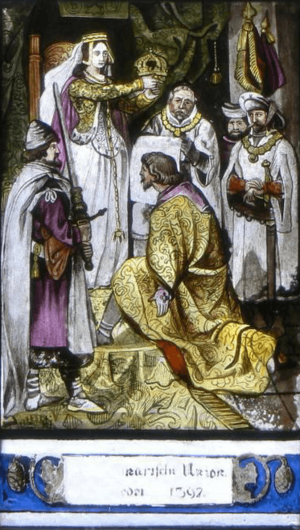
It was understood that Margaret would, when the time was right, choose a king for the three kingdoms. This king would be related to all three old royal families. In Norway, it was agreed that Margaret would continue to rule alongside the new king. In Sweden, the nobles said they were happy to have no king during Margaret's lifetime. In 1389, she named her great-nephew, Bogislav, as king of Norway. He changed his name to Eric of Pomerania. Margaret had adopted him and his sister Catherine. In 1396, people in Denmark and Sweden also accepted him as king. Margaret again became the regent while he was still young.
On July 20, Margaret used the happy mood to announce the famous Treaty of Kalmar. This was a very important document that officially joined Norway, Sweden, and Denmark. The date she chose was special. It was the feast day of St. Margaret of Antioch. Like Queen Margaret, this saint was also rejected by her father and put in prison.
The treaty suggested an "everlasting union." This was Margaret's biggest dream. It said that "all three realms should exist together in harmony and love." It also stated that "whatever happens to one, war or attacks from foreigners, that shall be for all three." Each kingdom would help the others. From then on, the Nordic kingdoms would have "one king, and not several."
Margaret knew about the pride and differences in each region. So, she was very careful. She promised her people that each state would be ruled by its own laws and customs. No new laws would be made without their agreement. Also, officials from governors to soldiers would be chosen from the local people. This showed her subjects that they would benefit from the union without losing their national identity.
To bring the united kingdoms even closer, Margaret called a meeting. The three Councils of the Realm met in Kalmar in June 1397. On June 17, Eric was crowned king of Denmark, Norway, and Sweden. The final Act of Union was never fully completed. Historians still discuss why. But the Union worked in practice until the early 1500s. The union between Denmark and Norway continued until 1814.
A few years after the Kalmar Union, Eric, who was 18, was declared an adult. People in all three kingdoms accepted him as king. However, Margaret was still the true ruler of Scandinavia throughout her life.
How Margaret Ruled the Kalmar Union
When the union was new, Margaret allowed the Riksråd (Royal Council) to exist. But they had little power. The Queen's authority was supreme. Important positions like High Constable were left empty. Margaret, who was a strong ruler, governed through her court officials. These officials were like very skilled clerks. Law and order were kept well, and she strictly controlled the power of the nobles.
Sweden and Norway were treated like parts of Denmark. National goals were not encouraged. However, Norway was treated better than Sweden because it was more loyal.
In 1396, Margaret issued a rule to better protect peace for the church, homes, farms, legal meetings, field workers, and women. She also showed her care for women in 1411. She gave 500 marks (a sum of money) to women who had been harmed during the wars between Sweden and Denmark in 1388–1389.
Margaret got back all the land that the Crown had lost before her father's rule. This process, called reduktion (land-recovery), was done very strictly. Hundreds of estates went back to the Crown. She also improved the Danish money system. She replaced old, worthless copper coins with good silver ones. This helped both her and the country a lot. She always had a lot of money, and she gave much of it to charity.
Historian Thomas Kingston Derry says Margaret tried to give the union a strong economic base. Her actions, like taking back crown lands from nobles and the church, and creating new taxes and coins, affected powerful groups. But she stopped them from gaining too much power. She did this by not using the separate councils of her three kingdoms much. Instead, she relied on a group of loyal and skilled officials she chose. She put Danes in charge of bishoprics (church areas) in Sweden and Norway. Royal lands and castles were managed by officials from other countries. Some have criticized this as favoring Danes over Swedes and Norwegians. But Derry believes Margaret mainly wanted a loyal and effective government. She even used more Germans in Denmark than elsewhere.
Margaret traveled a lot. In her later years, she spent more time in Sweden than in Denmark. She encouraged nobles from the three kingdoms to marry each other. She was also very religious. She strongly supported making St. Brigitta a saint. She helped make Vadstena an important cultural center. She also encouraged the use of "Brigittine language," which brought many Swedish words into Danish and Norwegian.
Unlike her adventurous father, Margaret's foreign policy was careful. She stayed neutral in the bloody war between France and England and other European conflicts. However, she worked hard to get back Danish land that was lost. She bought the island of Gotland from its owners, Albert of Mecklenburg and the Livonian Order. Most of Schleswig was also regained in the same way.
In 1402, Margaret talked with King Henry IV of England. They discussed a possible double wedding between England and the Nordic Union. The idea was for King Eric to marry Henry's daughter Philippa. Also, Henry's son, who would become Henry V of England, would marry Eric's sister Catherine. Margaret hoped that one day, these two unions would join to create an empire like Cnut the Great's. The English wanted these weddings to create an alliance that would involve the Nordic kingdoms in the Hundred Years' War against France. Margaret always avoided joining alliances and foreign wars. So, she rejected the English proposals for a double wedding. However, Eric did marry the 13-year-old Philippa in Lund on October 26, 1406. This created a defensive alliance. For Eric's sister Catherine, a wedding was arranged with John, Count Palatine of Neumarkt. This gave Margaret an ally in South Germany. This ally could be useful against the princes and cities of North Germany.
Death and Legacy
In 1412, Margaret tried to get Schleswig back. This led to a war with Holstein. Before this, she had successfully regained Finland and Gotland. While winning the war, Margaret died suddenly on her ship in Flensburg Harbor.
In October 1412, she sailed from Seeland. She attended several meetings that were going well. But when she went back to her ship, she was "seized with sudden and violent illness." Margaret seemed to know she was dying. She ordered money to be paid to a nearby monastery for prayers for her soul. There is no clear historical record about what caused her death. She died on the night of October 28, 1412. Some ideas for her death include the plague, shock from the death of a close advisor, or even poisoning by Eric.
Her sarcophagus (a stone coffin), made in 1423, is behind the main altar in the Roskilde Cathedral, near Copenhagen. She had left property to the cathedral. In return, Masses (church services) for her soul were supposed to be said regularly. This stopped in 1536 during the Protestant Reformation. However, a special bell is still rung twice a day to remember her.
Appearance and Personality
People described Margaret as a beautiful woman with dark hair and dark eyes. She had a strong gaze and gave off an air of complete authority. She was very energetic even when she was old. She was a strong and determined ruler. At the same time, she was also described as wise, fair, tactful, and kind. Historian Hudson Strode wrote that Margaret was "undoubtedly the strongest" ruler. He said she worked harder than any male official. She used her skills, diplomacy, and strong will to make the Union successful and keep royal power strong.
Understanding Her Titles
In Denmark, Margaret was called "sovereign lady and lord and guardian of the entire kingdom of Denmark." Norway and Sweden later gave her similar titles. This special title gave her the power of a man (lord), a woman (sovereign lady), and a neutral guardian. Later, when Eric was chosen King of Norway in 1392, she stopped using this title in Norway. In 1396, when Eric was crowned King of Denmark and Sweden, she stopped using the title completely. However, she continued to be the Regent.
She only called herself Queen of Denmark in 1375. Usually, she referred to herself as "Margaret, by the grace of God, daughter of Valdemar King of Denmark" and "Denmark's rightful heir." Her title in Denmark came from her father, King Valdemar IV of Denmark. Others simply called her the "Lady Queen," without saying what she was queen of. But Pope Boniface IX called her "our beloved daughter in Christ, Margaret, most excellent queen of Denmark, Sweden and Norway."
When she married Haakon VI of Norway in 1363, he was co-King of Sweden. This made Margaret queen consort. Even after they were removed from the Swedish throne, they never gave up the title. When the Swedes removed Albert I in 1389, it simply brought Margaret back to her original position. From February 24, 1389, to October 28, 1412, she was Queen of Denmark, Norway, and Sweden. She founded the Kalmar Union, which united the Scandinavian countries for over a century. She acted as the true queen of Denmark, even though it was not common for a woman to rule alone in Denmark at that time.
Her Reputation and Impact
E.C. Otte wrote in 1874 that if Margaret had been followed by equally skilled and fair rulers, the Kalmar Union could have been very good for the three kingdoms. She believed that each kingdom alone was weak and open to danger. But together, they would be a strong monarchy. This would allow them to stand up to attacks from German traders and enemies from Germany. It would also keep the Baltic Sea safe. However, no ruler after Queen Margaret was as great as she was.
According to historian Imsen, no one has ever questioned Margaret's political genius. But her reasons for doing things have always been debated. In the early 1800s, she was often seen as an idealist. People thought she fought to balance German influence. After Denmark's defeat in the Second Schleswig War in 1864, Margaret was seen as a nationalist. More recently, she has been viewed as a clever politician who mainly fought for her own power and family interests.
In The Middle Ages: Dictionary of World Biography, McFadden states that Margaret's achievement was huge. At a time when German culture and economy threatened all of Scandinavia, she united the kingdoms. She not only pushed back the Germans but also regained lost lands in the south. When she died, the Scandinavian Union was the most powerful force in the Baltic Sea. It was also the second largest amount of European land under one ruler.
Family Tree
| Valdemar IV of Denmark | Helvig of Schleswig | ||||||||||||||||||||||||||
| Ingeborg of Denmark | Margaret I of Denmark | Haakon VI of Norway | |||||||||||||||||||||||||
| Maria of Mecklenburg | Olaf II of Denmark | ||||||||||||||||||||||||||
| Catherine of Pomerania | Eric VII of Denmark | ||||||||||||||||||||||||||
Images for kids
See also
 In Spanish: Margarita I de Dinamarca para niños
In Spanish: Margarita I de Dinamarca para niños


